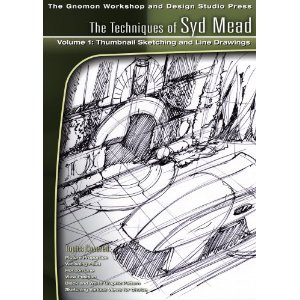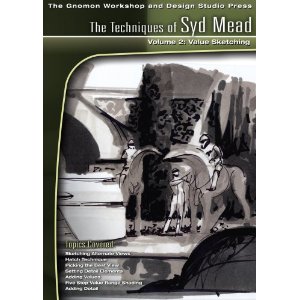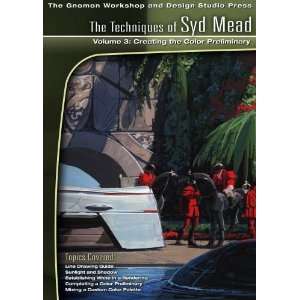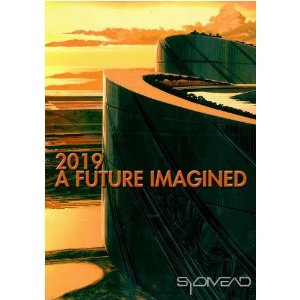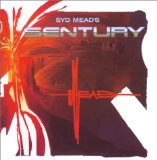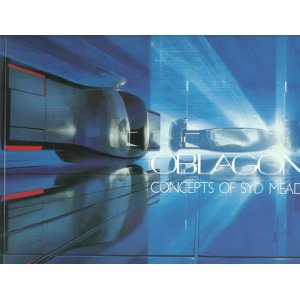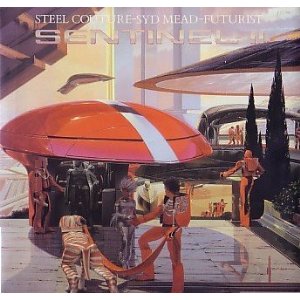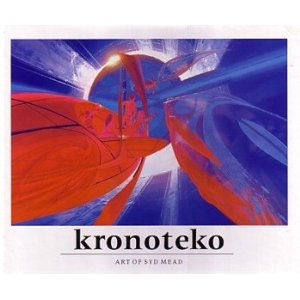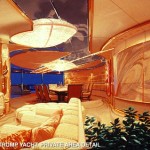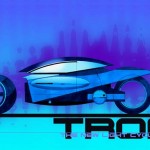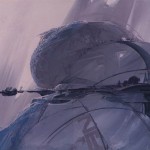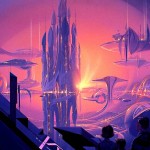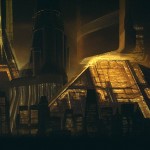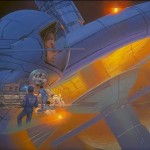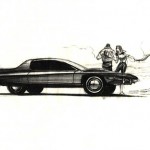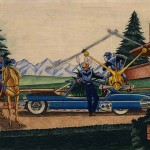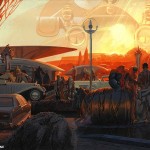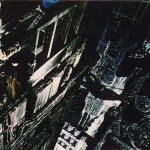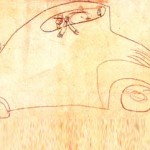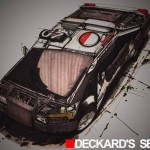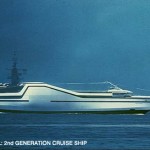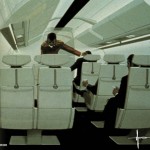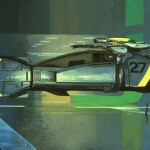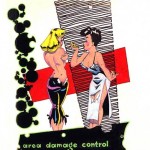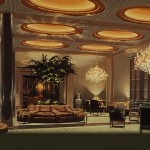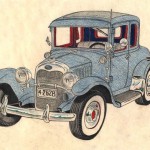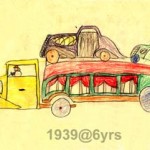Syd Mead
Beyond the limits of science, with nothing but his brush and a bold vision, Syd Mead paints and redefines the future. With a career spanning over several decades, his work has greatly influenced the way we view and sometimes even live in the future that once was. His vision greatly contributed to the look and feel of such films as Blade Runner, Tron and Star Trek: The Motion Picture to name a few. Discover the bold and fascinating world of Syd Mead.
CGC: Growing up, what inspired you to become what you are today?
All children like to make a mark. It is instantly satisfying visually and most kids eventually drift to other pursuits. I drew cars and rocket ships from the first grade instead of airplanes and houses with trees and flowers. I was fascinated with visualizing my ideas and perhaps had a dismal view of my peers. I thought they were boring.
As I got older (like, twelve and thirteen) I had honed my drawing skills to a fine tune and the satisfaction of accurately depicting my dreams and ideas fueled the fascination even more. So in an egotistical way, I inspired myself.
CGC: What’s your academic background?
I graduated from high school and then spent a year at the junior college level in Colorado Springs , Colorado . I then went into the army where I completed my GED hourly requirements. When I entered Art Center School I took additional academic hours to qualify for the California accreditation for a Bachelor of Professional Arts.
CGC: Even when you were very young, you’ve managed to travel quiet a bit. In 1953, you joined the US Army and traveled even more. How has this changed your vision of the world?
My father was a minister who shifted from one small church to another. Also, my parents conducted summer bible school sessions and that involved travel around the central states, and one trip to California during the war. I was fascinated by seeing dark blimps patrolling the Pacific coast in the San Francisco area. Traveling does, indeed ‘broaden’ one; you learn how to observe, to confront different ness and become a kind of detached ‘drop in’ to whatever scenario or situation you encounter. That served me well then and now.
CGC: From the original Star Trek, the Motion Picture, to Tron and Blade Runner, you created some of the most recognized worlds ever seen in the film world. What is your proudest achievement so far?
I worked on Star Trek: The Motion Picture in post production so I didn’t really ‘get into it.’ In fact I was going back and forth to Holland doing design consultant work with the Philips studios in Eindhoven all during my work on Star Trek: The Motion Picture. Blade Runner was the first movie I worked on from zero to release. In fact I was the first one hired as ‘staff,’ even though I worked as an off-site visual consultant. Remember that I also worked on TRON concurrently with post production matte creation for Blade Runner. And, I was doing other commercial work all through my involvement with both of those pictures. Also, be aware that I’d been successful professionally for twenty years before I ‘hit’ the movies! Working with Peter Hyams on 2010: The year we make contact was a thrill because I actually appreciated my contribution to a major film release. I was on the sets, worked with the model makers and had a warm relationship with Al Brenner, the production designer and complete rapport with Peter Hyams. So, based on the experience of really being ’embedded’ in the movie making process, 2010 was my most elaborate enjoyment of helping to ‘make’ a film.
CGC: Would you like to share some anecdotes from some of these projects with us?
Star trek: The Motion Picture
I was responsible for designing the V’ger entity. I was in a meeting at John Dykstra and Bob Shepherd’s facility, Apogee. The meeting was about the V’ger design. The director, Robert Wise, wasn’t happy with what I’d come up with so far and had come prepared with little slips of paper with an excerpt from the script. As he was ready to leave, he handed each of us a paper strip. On the strip of paper were the lines:
“…they were looking at something no man had ever seen before.”
That was my job. To invent something that ‘no man’ had ever seen before. . I did.
2010: The year we make contact
Peter Hyams called me up one day during the pre-production process. He asked for my help. I had furnished him with detailed sketches of the Leonov spaceship, and he had just come back from the model shop. He was upset.
“Syd, go out there and let me know what you think. I told them to scrap what they had so far and start over…”
I did. The model makers had gone ahead and used the ‘Star Wars’ model technique of gluing lots and lots of model parts onto a solid shape. Peter wanted the model to have surface detail depth, as I had designed it. The final ‘hero’ model was sixteen feet long, and when the camera moved around it you could see ‘into’ the surface detail, rather than just side lighting a base relief detail set.
CGC: Who are your favorite film directors to work with?
Each of the film directors I have worked with have their own methods, their own directorial style and therefore, individual expectations and visualisation demands. Peter Hyams gives you an explicit verbal ‘feeling’ of what he wants, as a story component. Ridley is visual and produces his own shot drawings…a kind of storyboard line sketch. That helps enormously to ‘hit’ the desired mark the first time out. John Badham (ShortCircuit) didn’t exactly know what he wanted until he saw it, which made the task of designing ‘Number Five’ an arduous, almost didn’t ‘get it’ job. Steven Lisberger (TRON) treated me as an absolute peer. The whole experience of working on TRON was a delight.
CGC: Favorite science-fiction writers?
Isaac Asimov and Robert Heinlein. I was invited to Heinlein’s house in Colorado Springs when I was in high school. That was a real treat!
CGC: Favorite Book?
Syd Mead’s Sentury? Hah! That’s very good. Of course I like it, having designed every page and writing every word. Honestly, I don’t really read that much. I keep up with technology by subscribing to the Economist, Forbes, buying Scientific American per issue and sometimes pick up a WIRED when I’m in the mood for hype and in-your-face cute ‘future’ stuff.
CGC: What type of projects appeal to you the most today and has this changed since you began?
My first years as a professional designer involved corporate graphics, product design, automotive design and build supervision for two show vehicles (one was never built due to the juvenile pique of one of the Ford Executives) and numerous graphic and illustration challenges. As the years progressed and I moved to Southern California I became involved in the movie and television industries and the business of working on designs and master plans for large, themed area projects. It should be noted that, as I mentioned before (?) that I was a successful professional for twenty years before the ‘movie’ biz involvement. I now still become involved in motion pictures by specific invitation and have enjoyed being a featured presenter in this country and abroad.
CGC: Computers have dramatically transformed the production environment over the past couple decades. How has this impacted your work process?
Computers only assist as an amazing ‘tool.’ Those who make 3D models, special effects and electronic graphical illustration do it all the time. They spend considerable time keeping up with the learning curve which re-formats every time a new generation of software is launched, primarily as a marketing ploy. Computer memory keeps increasing, allowing more and more elaborate capability for software expertise. I use computers primarily for compositing presentations (QuickTime) and archiving and enhancing sketches and other graphical design items. If the use of computers goes beyond my user level, the client has both the staff and the hardware systems to implement my designs.
CGC: You seem “Obsessed” about the future, why?
We are going to be in the future whether we ‘want to’ or not. The future is all of us. Those who insist on insulting human intelligence and effort deserve disdain in the same measure that we laud those who advance human invention and the human ‘condition.’ Regardless of contemporary abuses, the ‘human condition’ is getting better. Where it is not is no fault of the general trend to betterment, but the failure, specifically, of governments and dogma systems to address genuine human concerns. Am I ‘obsessed’ with the future? It is a place which will only be ‘better’ if we all work at it. I am completely disgusted with the current fashion-ability of dystopian ‘gothic’ scenario. I prefer to depict a future that is egalitarian and as ‘workable’ as we can collectively manage. My favorite self-quote? Science Fiction is reality ahead of schedule.
CGC: You started dreaming the future a long time ago. Now that we live in “The Future”, are you disappointed? (eg.: no flying cars)
I am disappointed by the complete failure of funded imagination being translated into infrastructure and general public lifestyle. Although capitalized social systems actually generate ‘new’ capital, there is, at any one time, only so much available. The ‘future’ was sabotaged by elaborate social support systems at the insistence of social mavens who invent need and then invent elaborate programs to ‘benefit’ their inventions. They rarely work. What they really do is transfer capital from working reward to creating vast financial support systems for elitist schemes. My other self quote: If there were no poor people, the social mavens would invent them.
CGC: If you could, with your paintings, create a world you could actually live in, what would it be like?
My world would be… Well, buy the book, dude! Seriously, what I have been painting for the last fifty years is ‘my world.’ I have had several opportunities to help invent submersive environments that were completely satisfying to those who went through them. If I had unlimited budget I would help create an egalitarian access social experiment. I know, it smacks of socialism but this would be a stylistic demonstration disguised as themed entertainment.
CGC: Your bio states your favorite material is chrome. Can you elaborate why?
Chrome, as I have stated, is ‘my favorite color.’ Chrome is a mirrored surface on whatever form it is applied to. It then becomes the visual world immediately around the chrome surface. That means that it tends to ‘disappear’ and be a reflected phenomenon of its immediate surround. To me, this is at once ephemeral and touchably ‘real;’ a combination which strikes me as almost mystical.

